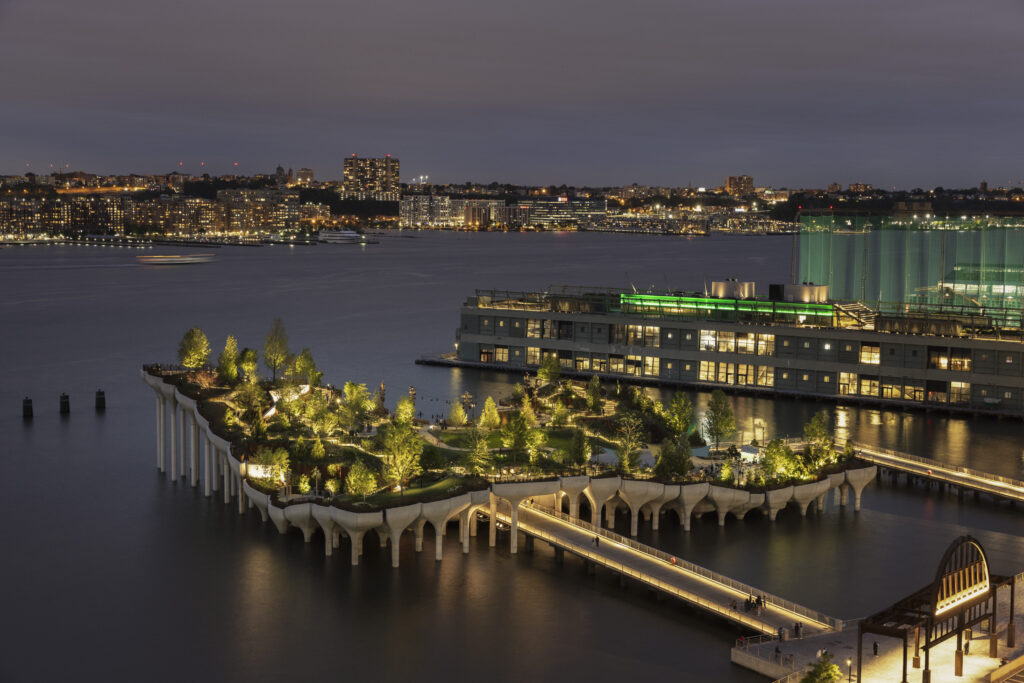This feature is provided by Fisher Marantz Stone (FMS). FMS team members attend and actively participate at LightFair as presenters, speakers, and thought leaders, driving the lighting design conversation forward each year.
For questions: Carla Ross Allen | [email protected] | 212-857-9216
Join Enrique Garcia Carrera at LightFair 2023 in New York City when he presents The Illuminated Little Island That Could | Wednesday, May 24, 2023 | 4 – 5 PM.
We invite you to visit New York for LightFair 2023 to take advantage of the city and enjoy this unique exterior experience of touring the Little Island.
Also read FMS’s October 2022 feature: Growing Community and Advocating for the Future of the Lighting Industry
A Unique Opportunity with Historical Context
A daring partnership between philanthropist Barry Diller and the Hudson River Park Trust, Little Island was born from the unique opportunity to envision repairing and renovating the historic riverfront Pier 54 along the west side of Manhattan within Hudson River Park. Designed by Heatherwick Studios in collaboration with Mathews Nielsen Landscape Architects, with architectural lighting by Fisher Marantz Stone, Little Island is an entirely new type of public space for New York City that creates an immersive experience with nature and art.
The story of Little Island begins in the early years of the 20th Century in Southampton, England, with the maiden voyage of the Titanic. Survivors of that ill-fated voyage would have set foot on dry land at Cunard Pier / Pier 54 on the Hudson River in Manhattan. In the era of transatlantic crossings, this pier was the NY anchor for the Cunard line. Three years after the Titanic tragedy, the Lusitania, which also set sail from Pier 54, was torpedoed and sunk by a German submarine, precipitating the entrance of the United States into World War I. Over time the pier fell into disuse, and its shed house was demolished, leaving only the pier platform and structural entry arch. More recently, the pier was used for recreational events.
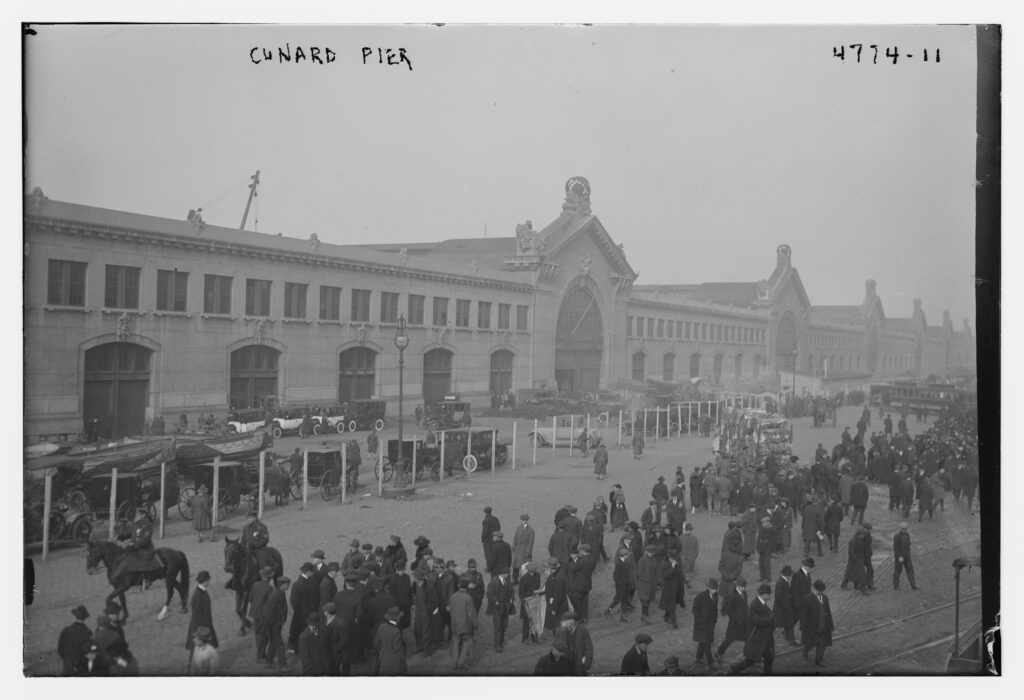
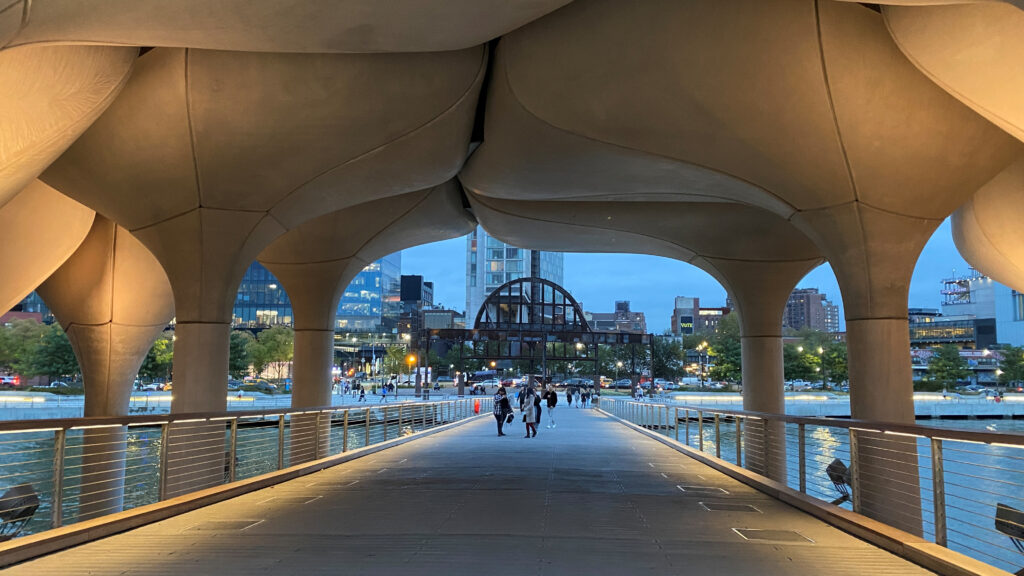
Creating a Luminous Environment
Fast-forward to 1998: the Hudson River Park Trust (HRPT) was formed to create and maintain recreational parks along the Hudson River in Manhattan, thus making it the largest park of its kind in North America. FMS was selected as the lighting designer for the waterfront master plan and began our fifteen-year partnership with HRPT.
“FMS was already involved with HRPT in creating the park system lighting masterplan and providing peer review for the lighting of each individual segment. As design for Little Island ramped up, HRPT included us in the list of potential lighting consultants. Following several interviews and negotiation sessions, the Little Island design committee awarded FMS the commission to help create the Island’s illuminated evening environment.”
Enrique Garcia Carrera, Associate Principal, FMS
At the outset of our commission, we were initially presented with a lighting brief to create a “luminous environment” that would “subtly highlight the concrete supporting structure – the “tulips” – and landscape features while keeping the lighting instruments as inconspicuous as possible. We did not understand at the time that lighting the ‘tulips’ would have unacceptable environmental ramifications, which constrained the lighting interventions we could consider. Further considerations for safety and wayfinding were important aspects of the brief. Pending weather conditions, the park is open until midnight, with year-round programming for evening performances.
Once the architectural, structural, and landscape elements were established, we began to imagine night lighting together with the architects. Several lighting elements were evaluated, such as emphasizing the columns and tulips and accentuating the landscape. But the lighting of the structure would have several obstacles, such as keeping the luminaires above the flood line and preservation of the marine environment, specifically avoiding stray light disrupting the underwater habitat of the American Eel (a protected species).
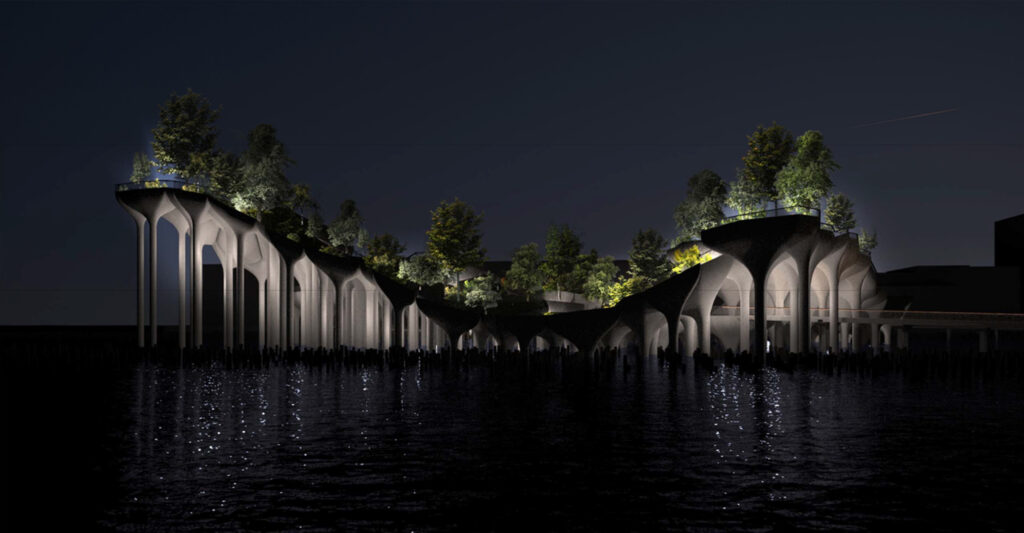
Illuminating Little Island: Overcoming Environmental and Other Challenges
This portion of the Hudson River is home to the American Eel, a species highly sensitive to light. Before the NYS Department of Environmental Conservation approved the project, we had to prove that our lighting design would not disturb the eel’s habitat.
To accomplish this, we first conducted a survey measuring existing light levels in the Hudson River along Manhattan’s western river edge. As expected in this metropolis, the levels vary, but generally, they were quite a bit higher than the levels we expected to obtain in our project.
Our next task was to calculate what levels of illumination would escape from the island and reach the surface of the river and then estimate the percentage that would reach the eel’s habitat several feet below the surface.
Finally, for all the fixtures near the water, we had to show that the light would be directed exclusively toward the surface of the park without the main beam of light being able to be directed toward the water.
Related: Also check out Roadway Lighting: Best Practices, Challenges, Myths, Impact on Wildlife
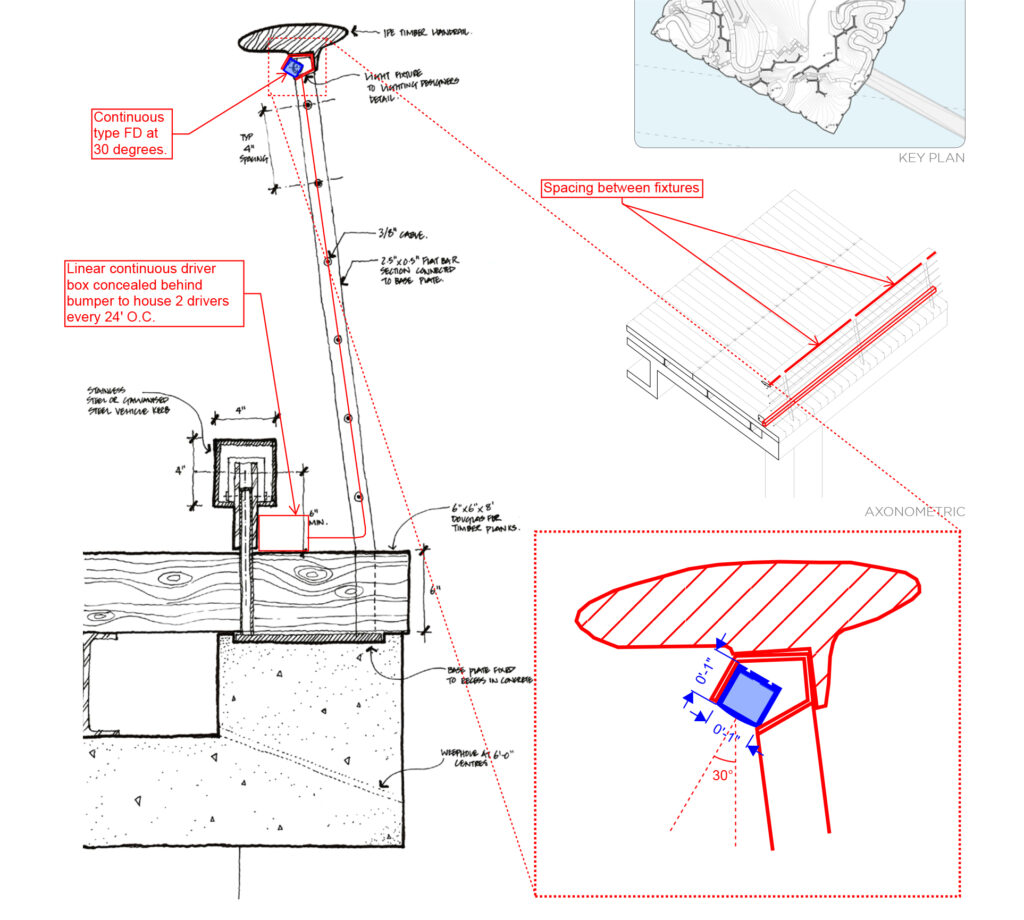
Designing Practically Invisible Outdoor Illumination
Another challenge was our client’s wish that the lights in the park be very low or practically invisible, a design problem we had to solve based on mandatory light levels for pedestrian safety and circulation on all paths and plazas. The FMS solution was to integrate small fixtures into the handrails throughout the site, meeting the requisite light level while providing a discreet integrated design solution that satisfied our client’s wishes.
Left: Calculations and Mounting Details – Image Credit: FMS
Related: Also read Illuminated Handrails Offer Innovative Solutions
Developing a Control System to Deliver Flexible Automated Control with Full Dimming Capacity
Parallel to the lighting design, we developed the parameters and specifications of the control system. We first organized the luminaires within control zones depending on their function and location. Being a park like no other in the city, with three distinct performance venues, each luminaire had to be fully controllable, programmable, and easy to operate by park staff. All luminaires would have the ability to be fully dimmed by means of a 0-10V signal. The lighting scenes would be activated automatically by means of an astronomical clock, although the park staff could modify them from anywhere through a mobile program and Wi-Fi signal.
More Challenges…and Light at the End of the Tunnel
All was moving forward with the project until September 2017, when the project was canceled due to opposition from various groups and by the increase in construction costs, which were more than ten times the initial estimate. The Design Team ceased work and proceeded to store project materials. But one month later, in October 2017, Andrew Cuomo, then Governor of NY State, interceded in favor of the project and convinced the opposing factions to stop their demands. Mr. Diller agreed to proceed with the project, but with the caveat that a substantial value engineering exercise be performed to identify and curtail runaway costs. For the lighting, this meant a great effort to reduce the components to the minimum possible while maintaining the essence of the concepts we had developed.
The Little Island that Could
Construction resumed for a few months, then stopped again in March 2020 because of the Covid-19 pandemic. Due to several unexpected factors related to post-pandemic living, e.g., the heightened value of outdoor space that allowed safe social distancing, state-mandated safety protocols, and construction work being designated an Essential Activity, Little Island was allowed to begin construction once again. Eventually, Little Island welcomed the FMS team back on the jobsite to undertake lighting mockups. For the FMS team, the mock-ups were crucial to confirm the lighting design before the final installation.
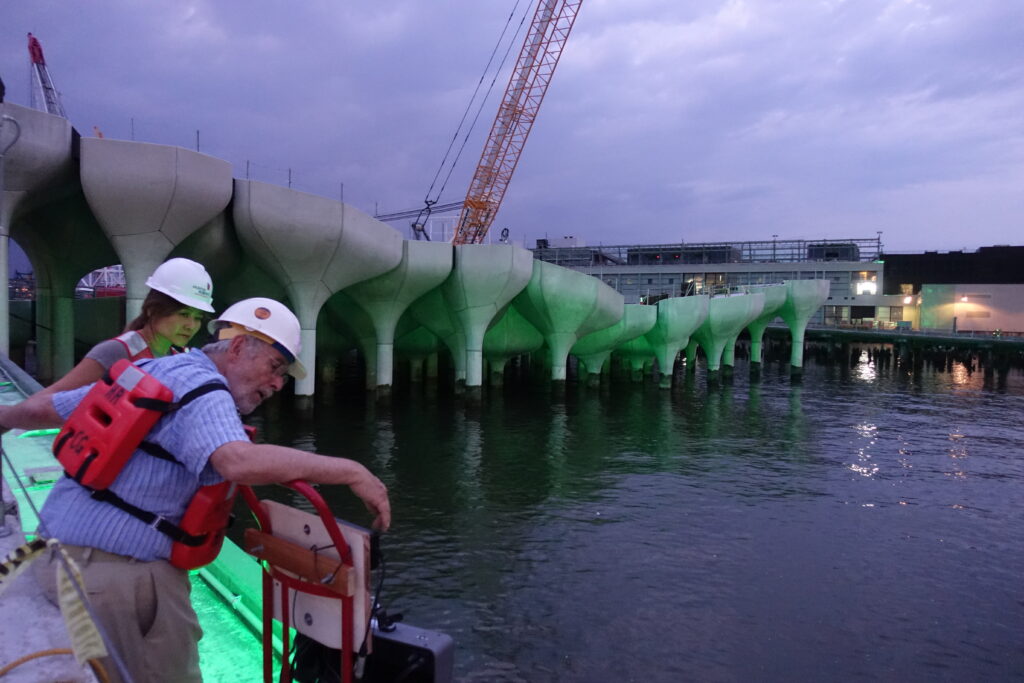
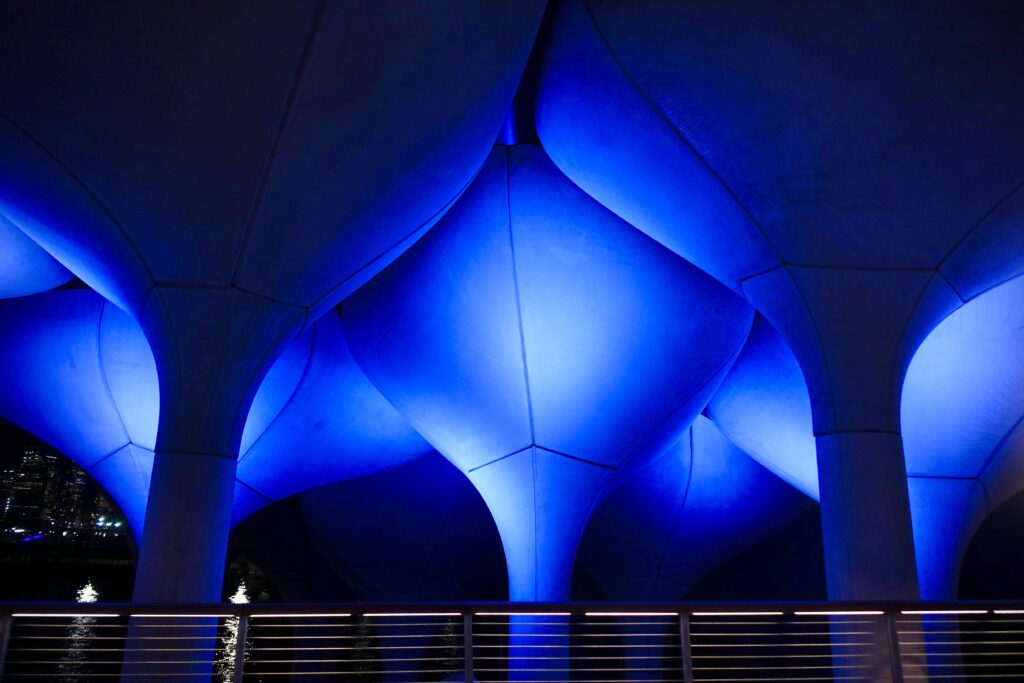
Little Island Finally Opens
Finally, the moment arrived that we had waited for through six intense years: In May 2021, it was finally time to open the doors of Little Island to the NY public, who were hungry for outdoor spaces where one could forget for a few moments about the pandemic that was still enveloping the city.
A festively illuminated park greeted the visitors, with the historic Cunard-White Star Line Arch, newly restored and sparkling with light, acting as an entry beacon leading to the luminous bridge and the uplit concrete pots supporting the park. Once on the Island, visitors can explore the various highlighted paths, ramps, and stairs, take in a show in the “Amph” (the amphitheater overlooking the Hudson) or marvel at the unparalleled views of New York City, the Hudson River, and New Jersey.
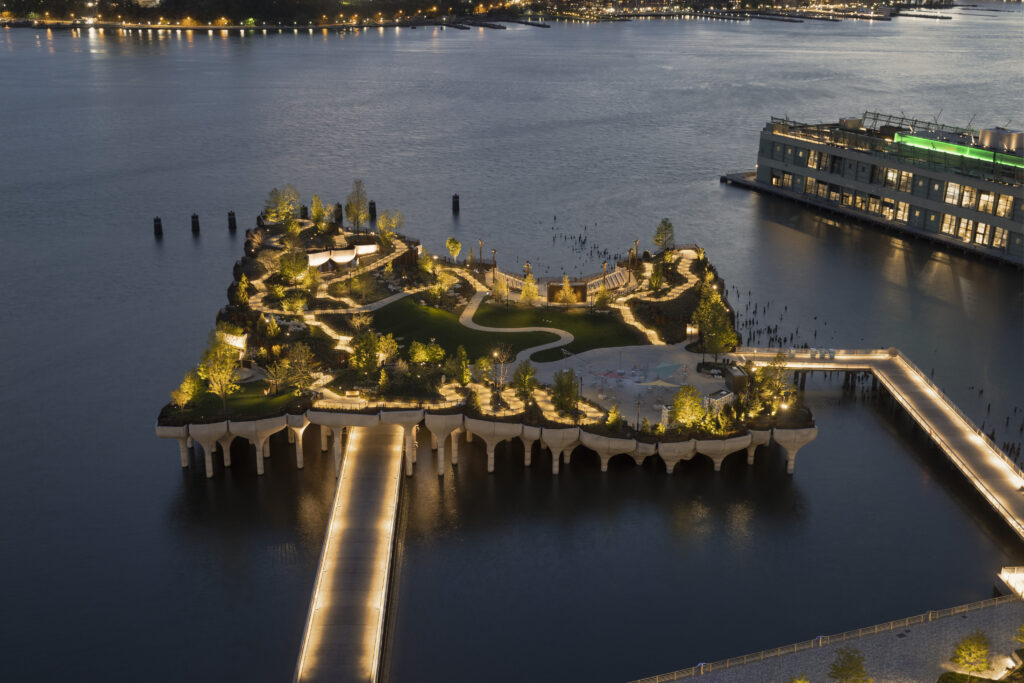
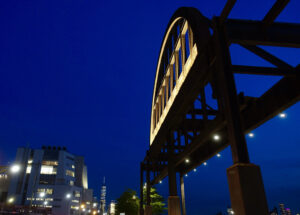
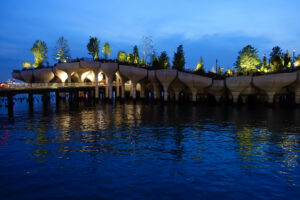
Little Island Project Team
Architecture: Thomas Heatherwick
Landscape: Mathews Nielsen
Engineering: Arup
Amphitheater: Charcoal Blue
Lighting: Fisher Marantz Stone:
Paul Marantz
Enrique Garcia Carrera
Miyoung Song

